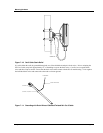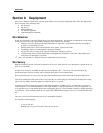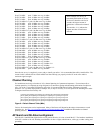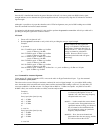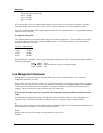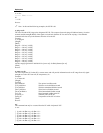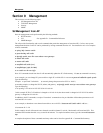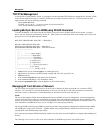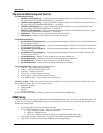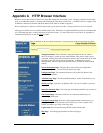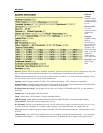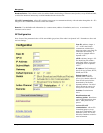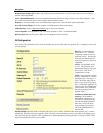
Management
Trango Broadband Wireless — Access5830 User Manual Rev. F page 41
Section 9 Management
This section covers the following topics:
• SU Management from AP
• TCP/IP SU Management
• Security
• SNMP
SU Management from AP
Network management can be performed by the following methods
• HTTP Interface
• CLI See Appendix B -- Command Set Reference
• SNMP Manager
The AP provides functionality and several commands that permit the management of associated SUs. In fact, most system
management functions for the SU can be performed by issuing commands from the AP. Presented below are a few examples
of these commands:
su <ping | info | status> <suid>
su powerleveling <all | suid>
su ipconfig <suid> <new IP> <new subnet> <new gateway>
su reboot <all | suid>
su restart <all | suid>
su testrflink <all | suid> [<r>]
su testrflink aptx [<pkt, 20..100>]
su sw <suid> <sw #> <on | off>
Note: SU commands issued from the AP will automatically update the SU’s flash memory. No save ss command is necessary.
As an example, you can change SUs password for a single SU or all the SUs in a sector: su password <all|suid> <pwd> <pwd>
Type the following:
Example: su password 7 hello hello (to remotely change the password on SU#7 to “hello”)
As another example, to change the SUs IP, subnet, and gateway: su ipconfig <suid> <new ip> <new subnet> <new gateway>
Type the following:
#>su ipconfig 7 192.168.10.10 255.255.255.0 192.168.10.1
In this example SU ID #7’s IP address is changed to 192.168.10.10, the subnet mask is changed to 255.255.255.0, and the
gateway is changed to 192.168.10.1.
In addition to the SU commands, a couple of “broadcast” commands are also provided that will broadcast parameters to all
associated SUs in a sector.
As an example, to broadcast a new channel/scan table to one or all SUs: bcastscant <all | suid> <ch #> <h | v>…
#>bcastscant all 5 v 2 h
In this example, the AP will transmit a new channel scan table (channel 5 vertical, 2 horizontal) to all associated SUs. This
command will broadcast the table every second for 60 minutes. To stop the broadcast sooner, type the command bcastscant
stop.
A complete description of these commands and many others can be found in Appendix B -- Command Set Summary.



